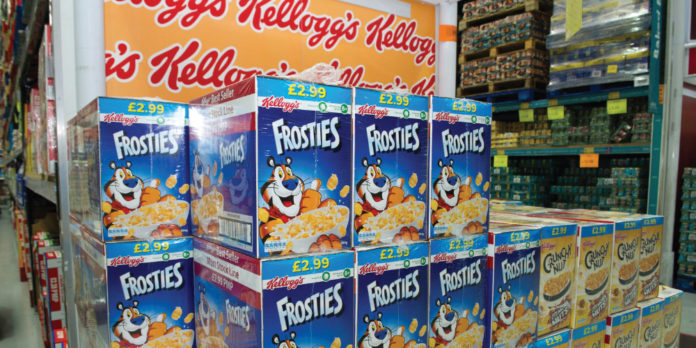Pricemarking requires balance. It can increase sales, but without increasing profits and can also undermine premium products. Toby Hill reveals the categories where it works best.
For wholesalers, pricemarked packs (PMPs) can feel like a mixed blessing. On the one hand, they understand the benefits PMPs bring to their customers, providing essential reassurance to convenience store shoppers and helping to drive impulse purchases. On the other hand, with price pressure from top to bottom proving tougher than ever, there are legitimate concerns about the shared margins that pricemarking offers.
Still, although doubts do exist, there is no doubt that pricemarking is here to stay – and is only likely to encompass more products in the future. Research by consumer analytics firm Him found that 44% of shoppers are more likely to buy a product if the pricemark is visible, and 53% are more likely to try a new product if it’s sold in a PMP. Overall, 76% of shoppers said that pricemarking improves their impression of a store’s value.
Even with all these obvious benefits, however, there is still a balance to be struck. Focusing on price point can drive volume sales, but does not necessarily lead to big profits. And with premium lines, pricemarking can undermine the sense that a product is a special treat, undercutting potential margins.
The right balance will differ for each particular store, so you may often want to consider offering your customers both pricemarked and non-pricemarked products.
As a result, learning to deploy pricemarking as effectively as possible is vital – and is only likely to become more so. Here, we look at several of the most important categories for pricemarked products, talking to suppliers about what wholesalers can do to manage pricemarking most effectively.
Soft drinks
If there is one category where pricemarking is crucial, it is soft drinks. PMPs account for more than half the annual £1.6bn of sales of soft drinks in the independent sector. Indeed, Him research found that 21% of shoppers won’t buy a soft drink from a convenience store if it isn’t sold in a PMP.
Responding to this trend, many major brands are deploying pricemarking more and more. Lucozade Ribena Suntory, for example, recently launched 79p PMPs on its classic Lucozade Energy 380ml line.
Similarly, Boost is also keenly aware of the power of pricemarking: “Most of Boost’s portfolio is permanently available as PMPs due to the success and growth in sales the brand has seen from this format,” says managing director Simon Gray. The 250ml Boost Original 49p PMP is the firm’s bestselling SKU, while its 500ml bottles are pricemarked at 79p.
Boost has carried this logic forward into its latest product development. The brand’s ready-to-drink Protein Boost comes in 310ml plastic bottles pricemarked at £1.29, available in Chocolate and Strawberry flavours.
Even at the premium end of the energy drinks category, pricemarking is vital, according to Rich Fisher, category development manager at Red Bull UK.
“Within the convenience channel, PMPs can significantaly increase retailers’ profits,” he says. “Wholesalers should highlight this opportunity to retailers to encourage them to stock a variety of PMPs.”
Accordingly, many of Red Bull’s products are available in PMPs, including the 250ml Red Bull Orange Edition and the 355ml Red Bull Original can.
Confectionery
Another category where pricemarking is crucial is confectionery, where most sales are impulse purchases. Wholesalers will therefore need to stock a broad range if they are to meet their customers’ needs, according to Susan Nash, trade communications manager at Mondelez International.
“Retailers will want to make sure they have a great display in key areas, so consumers can see PMPs – research has shown that 70% of purchasing decisions are made in-store,” she says.
Following Nash’s logic, Mondelez now offers its widest ever range of PMPs, making it easy for wholesalers and their customers to harness the benefits of pricemarking. The range includes Cadbury single bars priced at 50p, as well as a range of Cadbury tablets pricemarked £1. Beyond chocolate bars, its Cadbury Roundie and Belvita Breakfast’s Soft Bakes Choc Chip products have pricemarks of 50p.
However, Nash warns wholesalers not to overuse pricemarking: “PMPs are a type of promotion, so retailers will be considering how much of their stock they want perceived as being ‘on promotion’,” she says. “It can also be confusing for retailers to stock PMPs when they are also offering product group promotions such as meal deals – the PMP price could undermine another promotion in the store or confuse the customer.”
Tea, too
Pricemarking is also very effective on core essentials such as tea, according to Brett Grimshaw, business sector controller for convenience at Tetley: “Pricemarks are most important in high volume segments such as everyday teas and decaf where they help retailers demonstrate that they are offering value, and enabling them to compete with larger retailers,” Grimshaw explains.
He recommends PMPs for products that are showing high sales growth, of which there are several in the tea category, where consumer tastes are rapidly becoming more adventurous: “In the key growth area of green tea, our £1.49 PMP helps to attract interest and encourage trial of new, higher value teas, which shoppers might not have purchased before,” he says.
While pricemarking can be effective when applied to new or high-growth products, it should be used carefully at the more premium end of the sector – a vital area for retailers seeking to increase profits. In the case of premium tea, pricemarking can not only cut unnecessarily into a product’s margins, it can also erode the aura of it being a special treat worth paying extra to enjoy.
“Ultimately retailers’ focus should be on higher value sales, not bargain prices,” says Grimshaw. “Lower prices encourage shoppers to buy more and stock up, which can help volume sales but does little for profits.”
Sugar confectionery
Hanging bags of pricemarked sugar confectionery are a convenience store staple across the UK. Many suppliers have identified the popularity of the ‘round pound’ pricemark, launching several products in that line.
Wrigley, for example, followed the successful launch of £1 PMP hanging bags of Starburst and Skittles with a new product: 125g bags of limited edition Skittles Fruits and Sours, blending the two formats into one pricemarked bag.
Supplier Big Bear has also doubled down on £1 hanging bags, according to marketing manager Andrew Ovens: “We find that round pound deals work best on confectionery, from our most popular Fox’s Glacier range to the Poppets sharing pouches,” he observes. Big Bear’s range of pricemarked Poppets products includes mint, toffee and movie mix varieties. The firm’s Fox’s range encompasses Dark, Fruit and Mint.
“We know price sensitivity is still a huge factor in customers’ decisions in-store and this is unlikely to change in the coming 12 months,” Ovens adds. “With economic uncertainty and Brexit negotiations, consumers are wary of paying over the odds, and need reassurance they are getting great value.”
Gum
Wrigley is also pricemarking its chewing gum range. While retailers frequently prefer the freedom to set their own prices for single packs sold by the counter – an impulse purchase considered an essential for certain situations and so less dependent on price – Wrigley has found that pricemarking is an effective tool on larger packs and bottles, which people are more likely to buy with some planning.
Most recently, the firm’s sugar-free 46-pellet bottle has been launched in £2 PMPs in Peppermint and Spearmint flavours: “The launch of the new PMP bottle will help retailers improve rate of sale, as customer purchase intent in the gum category significantly declines at prices above £2,” says Dan Newell, confections marketing manager at Wrigley.
Everyday essentials
While pricemarking is often associated with impulse purchases, using it on everyday essentials is a great way for retailers to create an overall impression of value in their store. Manufacturer Princes has pinpointed the products it works best on including, unexpectedly, some more premium items such as olive oil. “We are selective in the products that we pricemark as they are chosen to reflect the needs of the convenience retailer,” says marketing director Graham Breed. “We have recently launched pricemarked Napolina Olive Oil & Extra Virgin Olive Oil 250ml for £2.49 and Napolina Olive Oil & Extra Virgin Olive Oil 500ml at £3.99.”
Princes also pricemarks Napolina Tomatoes, Jucee Squash, Branston Baked Beans and its whole range of canned fruit. “Wholesalers need to educate and encourage their customers to stock bestsellers in each category, to make the most of the opportunity presented by PMPs,” Breed advises. “An effective merchandising option is to position must-stock products alongside related PMPs. This makes the category easier to shop at the wholesaler, and can help retailers when it comes to arranging products in-store and driving maximum sales.”
On-the-go snacking
Finally, pricemarking remains most effective in the context of impulse-led categories such as on-the-go snacking. Peperami manufacturer Jack Link’s, for example, uses the promotional technique to drive sales across the whole of the range.
Despite the effectiveness of pricemarking, Jack Link’s marketing manager Pavan Chandra acknowledges that it’s not all plain sailing: “Ensuring that the price point for PMPs is competitive remains a challenge for wholesalers,” she says. “Peperami’s PMPs are based on research across the independent and wholesale market, across many product formats, to find the price point most frequently charged by most retailers.”
Chandra adds that pricemarks are only effective if they are clearly visible to the customer, particularly in an impulse category such as on-the-go snacking. Accordingly, the firm offers branded display units, including parasite units, which hang off shelf edges, freeing up shelf space for other products.
Retailer Views
 “We have pricemarking on as much as 80% of our stock now. There are certain things that aren’t pricemarked, like anything we want to premium price, such as bottled water or fresh cakes. But these days, margins are often better when products are pricemarked and it gives customers confidence, so why not use it?”
“We have pricemarking on as much as 80% of our stock now. There are certain things that aren’t pricemarked, like anything we want to premium price, such as bottled water or fresh cakes. But these days, margins are often better when products are pricemarked and it gives customers confidence, so why not use it?”
Bob Sykes, Denmore Premier Store, Rhyl, Denbighshire
 “The biggest problem is the churn on prices of similar products: for example, we might have the Double Decker at 50p and the Boost at 55p, which looks disjointed and messy. It would help to have some warning so we can work around that when planning our displays.”
“The biggest problem is the churn on prices of similar products: for example, we might have the Double Decker at 50p and the Boost at 55p, which looks disjointed and messy. It would help to have some warning so we can work around that when planning our displays.”
Vince Malone, Tenby Post Office, Tenby, Pembrokeshire
 “I’m always happy to use pricemarking, as long the margins are there. For some products, this isn’t a problem, such as soft drinks. But with confectionery, the margin can be squeezed right down – £1 Cadbury blocks have a margin of just 17%, for example. If the margin is too low, I won’t stock it.”
“I’m always happy to use pricemarking, as long the margins are there. For some products, this isn’t a problem, such as soft drinks. But with confectionery, the margin can be squeezed right down – £1 Cadbury blocks have a margin of just 17%, for example. If the margin is too low, I won’t stock it.”
Peter Mann, Nisa Local,
Luton, Bedfordshire
 “Pricemarking makes customers think they’re getting a good deal. We go mostly with cereals, some canned drinks and 500ml bottles at £1. The margins are fine – usually around 20% or 25%.
“Pricemarking makes customers think they’re getting a good deal. We go mostly with cereals, some canned drinks and 500ml bottles at £1. The margins are fine – usually around 20% or 25%.
“But having said that, you’ve got to have a balance. You don’t want it to look like everything is on promotion, so it’s good to have non-pricemarked alternatives, too.”
David Lewis, Spar Crescent Stores, Witney, Oxfordshire








